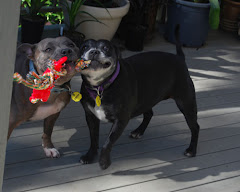Isn't it funny that as a Digital Immigrant working with new technologies you always seem to be questioning yourself. "Am I doing something wrong?" or "There must be an easier way to do this". At times like this the term 'funny' does not seem appropriate and another 'f' word comes to mind, 'frustrating'.
Last night it took me what seemed like an eternity to do something that I thought would be quite easy. I have not used a YouTube video as a teaching tool before, I suppose through my limited knowledge of this program, however I know that they are used all the time within classrooms as a successful and engaging pedagogical tool. When exploring YouTube and a similar site called TeacherTube the biggest problem that I seemed to encounter was the time it took to find a video that suited the subject area I am working with, as there is such an enormous amount of content on these sites.
The key word here is 'problem' and just like many times before throughout this course I found myself feeling a little uneasy about the task at hand. Thankfully this is quite normal and is the way this course has been designed. Problem-based (PBL) learning requires you to "take an active role in solving whatever problem situation you are presented with" (CQU, 2002). These situations are realistic and authetic and are likely to occur in real life, so the ability to problem-solve is highly prized in the workplace (CQU, 2002).
YouTube is a video sharing website that allows you to watch videos, upload videos that you have made and interact with other YouTube users around shared interests. Videos can be sent as a link on emails, embedded on blogs and Websites and can even be watched from mobile phones (YouTube, 2009). It is important to note that some schools do not have access to video sharing Websites. This problem can be overcome by downloading videos using KeepVid where they can then be uploaded to the class website or played at school. This program also eliminates the possibility of students accessing harmful or inappropriate material that is on the internet.
The clip that I have chosen is a photostory called 'Animal Habitats' and could be used to introduce students to the topic or as an engaging video to use during the current unit 'Creatures on the Move'. Some questions that are raised during the video could be used for further discussion or investigation such as 'Where do animals live? What do animals need to live? Within my grade 1 classroom, as part of their summative assessment, students are required to create an imaginary creature and have an understanding of its habitat, needs, food and features. Students use this knowledge to create an environment appropriate for their imaginary animal and this video shows some examples of student created habitats which I feel would be valuable.
When searching through TeacherTube I came across a video that I remember our lecturers showing us in a tutorial last year. Why do I remember it so clearly? Because I found it very engaging! While it would not be appropriate to use for Primary students I feel that it could be used successfully during a culminating social science project for Secondary students. It is titled 'We Didn't Start the Fire' and, using Billy Joel's famous song of the same title, aims to give a brief history of the USA. Hope you enjoy it!
References:
Central Queensland University. (2002). Problem based learning: PBL Students. Retrieved August 14, 2009, from http://pbl.cqu.edu.au/content/studs.htm
YouTube. (2009). Handbook. Retrieved August 10, 2009, from http://www.youtube.com/t/yt_handbook_home
Friday, August 14, 2009
Subscribe to:
Post Comments (Atom)







No comments:
Post a Comment